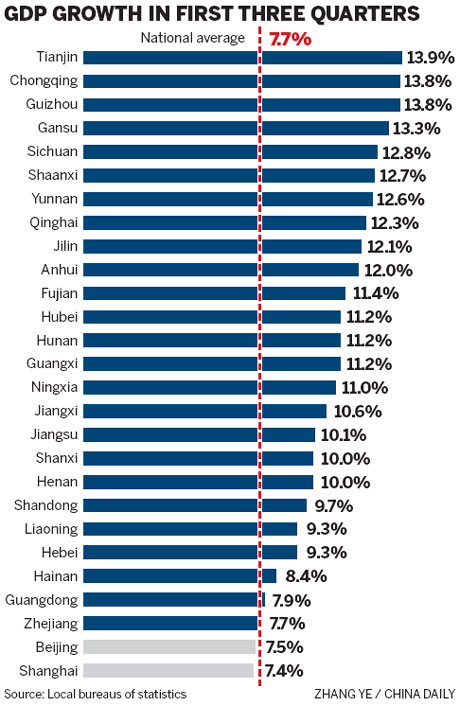
A total of 24 provinces, autonomous regions and municipalities across China have delivered economic growth above the national average in the first three quarters, while growth in coastal regions ramped up in the third quarter, according to local government data.
|
 |
|
 |
North China's Tianjin led the nation with 13.9 percent year-on-year GDP growth in the first three quarters, while Guangdong, the country's economic powerhouse, posted 7.9 percent year-on-year growth.
In the first three quarters, China's economy grew 7.7 percent, the lowest in the past three years. National figures are not necessarily a compilation of local data.
But an improvement for coastal regions' GDP figures suggests the country's growth decline might be stabilizing, as eastern provinces are regarded to be the most sensitive to economic fluctuations.
Among the 11 regions that saw more spirited economic activity in the third quarter, seven are coastal areas. Guangdong's GDP growth in the first three quarters was 0.5 of a percentage point higher than that recorded for the first half of the year, while Zhejiang's growth in the first three quarters was 0.3 of a percentage point higher than in the first half.
Li Wei, an economist at Standard Chartered Bank in Shanghai, said the acceleration in the eastern provinces' growth is "restorative" as it had generally been declining since the middle of 2011.
Li attributed the growth to the slow recovery of the US economy and a batch of local government stimulus packages.
"But the positive effects of the massive investment stimulus package introduced by the central government in 2009 are fading, while its negative effects are surfacing, which is taking its toll on central and western China," Li said.
He added that the current economic slowdown is mostly cyclical rather than structural, as the absence of massive investment schemes and a global economic malaise, rather than weakening domestic demand, were the major contributory factors.
Domestic consumption contributed to 55 percent of GDP growth in the first three quarters, which was the first time it had contributed to growth more than investment.
But Ha Jiming, vice-chairman and chief investment strategist of Goldman Sach's investment management division for China, said in a recent interview that structural factors, such as rising labor costs, accounted for 40 percent of the current slowdown.
"If structural factors, rather than cyclical ones, are the major causes, a large stimulus plan from the government would be of little help," Ha said.
zhengyangpeng@chinadaily.com.cn

 Domestic auto lineup looks overseas
Domestic auto lineup looks overseas Electric car industry in the slow lane
Electric car industry in the slow lane Brighter days for solar power
Brighter days for solar power Market flat, Japan-brand sales plummet
Market flat, Japan-brand sales plummet